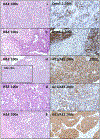Mesothelioma: Scientific clues for prevention, diagnosis, and therapy
- PMID: 31283845
- PMCID: PMC8192079
- DOI: 10.3322/caac.21572
Mesothelioma: Scientific clues for prevention, diagnosis, and therapy
Erratum in
-
Erratum: Mesothelioma: Scientific clues for prevention, diagnosis, and therapy.CA Cancer J Clin. 2020 Jul;70(4):313-314. doi: 10.3322/caac.21607. Epub 2020 Mar 6. CA Cancer J Clin. 2020. PMID: 32767692 No abstract available.
Abstract
Mesothelioma affects mostly older individuals who have been occupationally exposed to asbestos. The global mesothelioma incidence and mortality rates are unknown, because data are not available from developing countries that continue to use large amounts of asbestos. The incidence rate of mesothelioma has decreased in Australia, the United States, and Western Europe, where the use of asbestos was banned or strictly regulated in the 1970s and 1980s, demonstrating the value of these preventive measures. However, in these same countries, the overall number of deaths from mesothelioma has not decreased as the size of the population and the percentage of old people have increased. Moreover, hotspots of mesothelioma may occur when carcinogenic fibers that are present in the environment are disturbed as rural areas are being developed. Novel immunohistochemical and molecular markers have improved the accuracy of diagnosis; however, about 14% (high-resource countries) to 50% (developing countries) of mesothelioma diagnoses are incorrect, resulting in inadequate treatment and complicating epidemiological studies. The discovery that germline BRCA1-asssociated protein 1 (BAP1) mutations cause mesothelioma and other cancers (BAP1 cancer syndrome) elucidated some of the key pathogenic mechanisms, and treatments targeting these molecular mechanisms and/or modulating the immune response are being tested. The role of surgery in pleural mesothelioma is controversial as it is difficult to predict who will benefit from aggressive management, even when local therapies are added to existing or novel systemic treatments. Treatment outcomes are improving, however, for peritoneal mesothelioma. Multidisciplinary international collaboration will be necessary to improve prevention, early detection, and treatment.
Keywords: BRCA1-associated protein 1 (BAP1); asbestos; cancer syndromes; chromothripsis; gene-environment interaction; immunotherapy; mesothelioma.
© 2019 American Cancer Society.
Figures





References
-
- Baumann F, Ambrosi JP, Carbone M. Asbestos is not just asbestos: an unrecognised health hazard. Lancet Oncol. 2013;14:576–578. - PubMed
-
- Goodman JE, Nascarella MA, Valberg PA. Ionizing radiation: a risk factor for mesothelioma. Cancer Causes Control. 2009;20:1237–1254. - PubMed
-
- Attanoos RL, Churg A, Galateau-Salle F, Gibbs AR, Roggli VL. Malignant mesothelioma and its non-asbestos causes. Arch Pathol Lab Med. 2018;142:753–760. - PubMed
Publication types
MeSH terms
Substances
Grants and funding
LinkOut - more resources
Full Text Sources
Other Literature Sources
Medical
Research Materials
Miscellaneous

